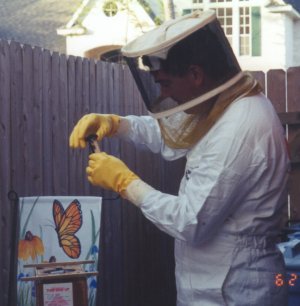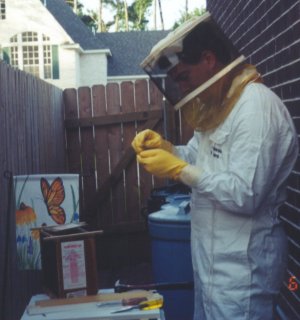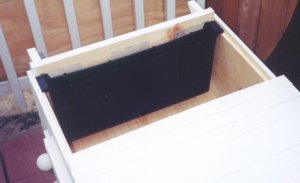My First Installation: A package of Midnite bees.
My wife was kind (and brave) enough to take these photos of the first time I ever tried to work with bees.
My Second Installation: Two Starline queen bees
After disaster struck over our summer vacation (our TBH overheated and all combs fell, eventually killing our Midnite queen), we built a 3-frame observation hive and I bought two Starline queens from York Bee Co.
Observation Hive
I removed the cork from the candy end of the first queen cage and punched a small hole through the candy with a sharp nail. I removed the top frame of the observation hive and placed the queen on the top of the middle frame. I then closed the hive entrance with screen and closed the glass door.
I then removed (from the TBH) the top bar that had the most comb and bees on it. I sprayed them with sugar water and then hit the top of the bar dumping them into a small bowl. I then open the top cover of the observation hive and dumped these bees in it. I closed up the top cover and installed a full jar of sugar water for them to feed from. In my design the feeder is at the top of the hive and robbers can't get to it.
Unfortunately, I learned the hard way that this was not the proper way to install bees in an observation hive. The bee must be started with all frames fully drawn. There must be at least one full frame of brood and one full frame of food stores (honey/pollen). The queen will also require at least a half pound of bees. I had none of these and accordingly, robbers wiped out this hive very shortly.
Top Bar Hive
I removed the cork from the candy end of the second queen cage and punched a small hole through the candy with a sharp nail. I placed the queen cage on the floor of the hive near the frames in the middle. I then replaced the top bar with the comb into the TBH. I topped off the division board feeder.
This hive did fine for a while and then suddenly our queen disappeared. The hive died out from robbing shortly thereafter.
My Third Installation - The tried and true method
My third attempt to successfully raise bees was to purchase a well established Langstroth hive from a fellow beekeeper, Mr. Jim Stowe of the Montgomery County Beekeepers Association. He sold us a hive that had two deep brood boxes and two medium supers. This is the only hive we have that's currently housing bees.
This page was last modified 04/14/02 06:45 PM









